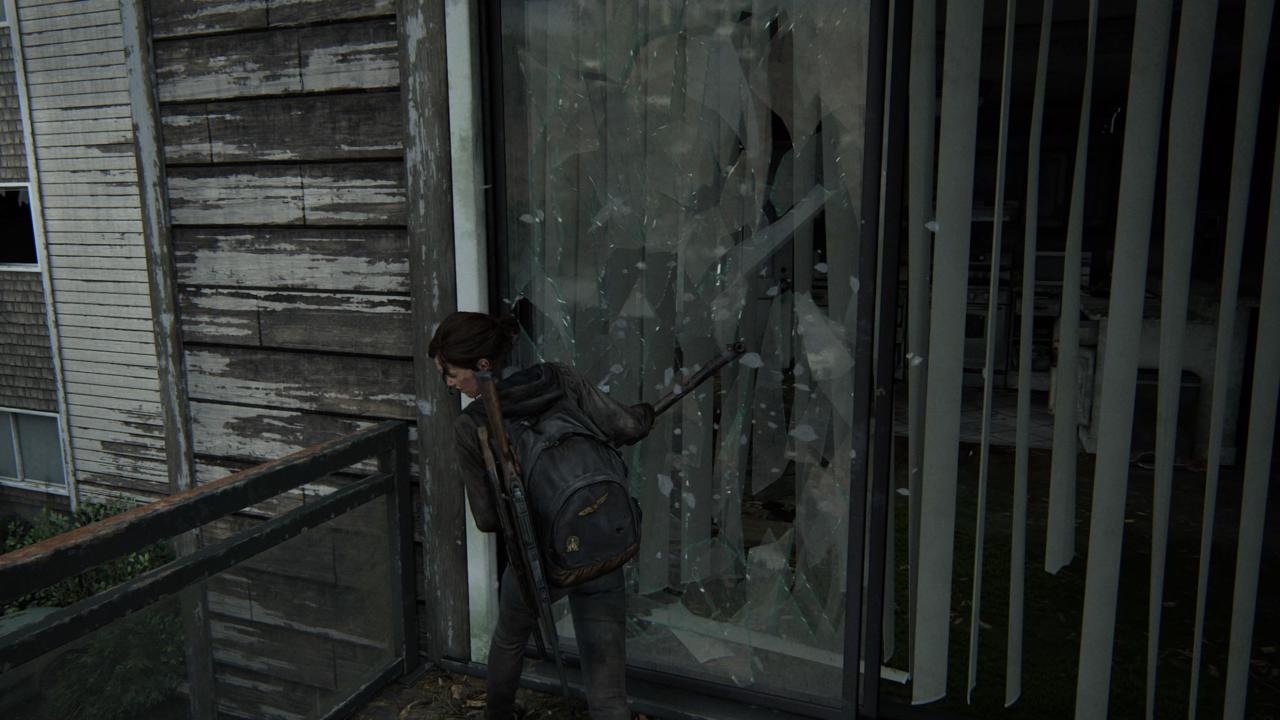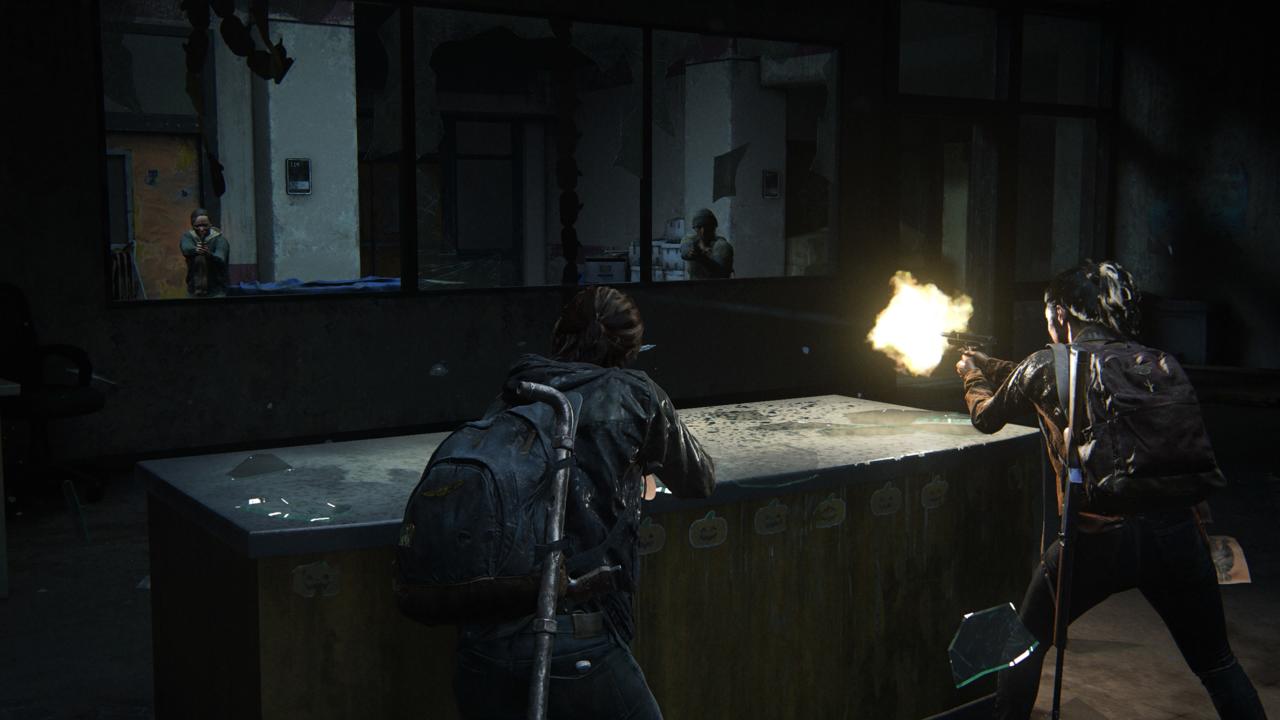It can often be the smallest of details that make the biggest impacts on the player experience in a video game. The way a gun feels satisfying to shoot thanks to small recoil animations or delicately balanced sound effects. The feeling of weight as a character moves due to precisely calculated animations reacting to your varied degrees of input. It's not uncommon for Naughty Dog to be included in conversations about such elements, with the studio packing in extremely high levels of details into both their worlds and characters. But in The Last of Us Part II, one effect and its popularity with players took even the studio by surprise.
There are so many little details to Naughty Dog's sequel that bring the dreary world to life, but none stand out more prominently than its deeply satisfying glass-breaking mechanics. Whether you're shattering the display window of a derelict bookstore or using your elbow to break through a weapon display case, there's a tangible sense of joy that follows through with each action. It's difficult to pin down one reason for it though. Perhaps it's the dynamic nature of the cracking and the way pieces of glass remain reactive once they're scattered on the floor. Maybe it's the way it forces you to think about puzzles, giving you avenues to pursue solutions in ways that other games might restrict you. It could just be sensory, too, with the right amount of vibration accompanying the crunchy sound of the glass fracturing. Developers at Naughty Dog didn't just focus on any one of these aspects, but instead sought to create a system unlike any they had played with before.


"I liked the glass breaking in the movie John Wick," Jesse Garcia, a sound designer at Naughty Dog, explained. "You hear a nice explosive impact along with the glass layers. After that, a very nice, subtle glass debris rolls on the ground. This extra layer of detail gave not only the feeling of breaking glass but also the consequence that there is now glass all over the ground. This type of storytelling was exactly what we set out to achieve."
Glass pieces do occupy a space around you once broken, rattling on the floor as you move by and cracking further under the pressure of a character's foot. But it's also the way the shards end up there that was important in the development process. "The main goal I remember was the player seeing a 'unique' glass shatter every time they break a window," added Neilan Naicker, a dynamics and technical artist on the game. "However, because the glass doesn’t actually fracture in real time, we had to get creative."
The fact that glass fractures in The Last of Us Part II aren't dynamic might surprise you. In reality, simulating accurate breaks takes a lot of processing power on the part of the PlayStation 4, requiring computations to take into account the surface area you're hitting, the force you're applying, and the object applying the force. It's not impossible, but it is impractical, especially when you're working within the tight performance budgets that a game like this does. So instead, Naughty Dog's designers did what lots of game designers do--they faked it.
All of the glass in The Last of Us Part II is, in fact, broken at all times, with some clever tricks used to hide the seams when it's meant to look intact. Making sure this looks convincing from all angles was one challenge, but then determining which pieces remained interactive after impact, as well as how the transition from whole to shattered takes place based on the circumstances of the impact, were others entirely.
"The biggest piece of tech on my end was helping implement the system that pre-processes the glass, so that the broken edges only appear as the glass breaks," Naicker said, detailing his involvement with the system. "Doing a melee move on the window applies a different force versus a more physics-based interaction, such as throwing a brick through said window. The windows are ultimately a physics-based setup and react accordingly to each method. We tested a bunch of different ways of breaking glass (throwables, bullets, melee, explosions) and tuned the response to make sure each felt satisfying."

Tuning this wasn't just to replicate the sensation as closely as possible, but also to give it a sense of "hyperreality" so often overlooked in games. There's often a push to make things as realistic as possible, but Naicker believes that won't always produce the best results. "I don't think being perfectly realistic is always absolutely desirable--but you often need to get close before you can start 'heightening' the reality," he said.
Knowing how glass would react to player interaction is something Naughty Dog settled on early, which is evident in how many times breaking it appears in puzzle solutions. Circumventing a locked door becomes a lot easier when you can just break the glass window next to it instead of hunting for a key--a nice touch that adds to the believability of the world you explore in the game. But giving that freedom to level designers presented another challenge to Naughty Dog's programming team, who suddenly had to find a way to take this precisely processed system and apply it to any glass dimensions required.
The main goal I remember was the player seeing a 'unique' glass shatter every time they break a window. However, because the glass doesn’t actually fracture in real time, we had to get creative.
Neilan Naicker, LOU2 Dynamics and Technical Artist
Calculating how well you can fake glass breaking in just one scenario is tough enough, but The Last of Us Part II uses breaking glass in anything as small as a weapon display to something as large as the side of an office building. Scaling this system so that level designers had the freedom to use it in the ways they wanted was tough.
"As any game programmer can tell you, a scale is a feature that can wreak havoc into many parts of your engine," Naughty Dog programmer Jaroslav Sinecky said. "If you want to support a non-uniform scale, things get much more complicated. If you want to non-uniformly scale breakable objects with collision, it can become a real headache."

Getting the glass to look great when smashed to bits and giving designers the freedom to use it wherever they want are just two pieces of the complex puzzle, neither of which would work at all if the player's destructive actions weren't rewarded with the ever so satisfying sound of the shatter. At a surface level, this might sound like the simplest part of the process--get some audio equipment setup and start grabbing as many samples as you can of real-life glass breaking. But like most things in game development, the reality is far more complex.
"When talking about the sound for glass, it is important to know there is not one glass break that is a single recording of 'glass breaking' from start to finish," Garcia said. "The glass breaking is made up of many different layers with many variations. We essentially are making the building blocks for the sounds of breaking glass and arranging them in order to synthesize the sound and feeling of breaking glass."
This process is broken up into three phases: Destruction, Physics, and Foley. Destruction itself is broken up even further into four sub-categories, all with distinct sound signatures inserted in split-second intervals during a single glass break. These layers, named Impact, Thump, Pane, and Debris, are where most of the audio engineering magic happens.

Impact is the initial sound you hear, as an object makes contact with glass for the first time. Here Garcia used glass breaking samples to find that ideal "cracking" sound to give weight to the force being exerted, but also leaned on electrical zaps to round out the effect. "Electricity can be used in all sorts of design. When used in the right way, it can be completely hidden to only give you one piece of an element you are looking for," he said.
When talking about the sound for glass, it is important to know there is not one glass break that is a single recording of 'glass breaking' from start to finish. The glass breaking is made up of many different layers with many variations.
Jesse Garcia, LOU2 Sound Designer
The Pane layer was important for the scalability of the entire system, giving different sound to the different sizes of glass being destroyed to add the sense of size and weight to all other layers. This was then followed by the Thump layer, which Garcia said wasn't created with samples of glass at all. "This is a processed low-frequency hit that gives your initial impact a nice shock to the body to help give the player a feeling of power and strength as they break the glass," he explained.
The final layer, Debris, ties back into Garcia's goal of recreating the sounds he heard in John Wick. Here, a mixture of short and long glass debris trails were used to give presence to the glass now scattered on the floor around you, which continues making noise as you interact with it further. "This helped get the realism to stick," Garcia said. "I used this layer to sell the aspect of storytelling. When you hear the debris scatter along the ground, you know there is now a sea of glass laying on the ground around you."
That glass influences gameplay too, especially in combat scenarios. If a grenade happens to shatter the windows of a handful of cars, that glass persists on the ground to offer enemies another way to detect your movements. Walking over the debris uses this layer to generate more noise for the AI to potentially pick up on, giving the system an additional element of consequence. To drive this effect home even further, senior sound designer Neil Uchitel modelled sounds for differently sized pieces of glass debris, giving the crunch you hear underneath your character's boots an accurate reproduction.

The glass system in The Last of Us Part II is not the result of one person. It takes a village of people to get just one element in the game to work, from programming, animation, design, foreground, and audio.
Jesse Garcia, LOU2 Sound Designer
Features with this depth to their detail are products of multiple teams of people working in harmony together. It's a testament to the thoughtfulness put in by each department involved, working together to not only challenge themselves but ensure it doesn't come at the expense of the player experience. It's not always a straight road to success. Garcia recalled an instance where issues arose when multiple instances of glass broke all at once, causing a variety of performance and effects issues. Scaling these hurdles requires tight teamwork, which Garcia praised during the development of the game.
"The glass system in The Last of Us Part II is not the result of one person," Garcia said. "It takes a village of people to get just one element in the game to work, from programming, animation, design, foreground, and audio. One of the strengths we have at Naughty Dog is having these departments work so well and seamlessly together, in our systems and our studio as people."